You can preserve tomatoes for up to 5-6 months using wood ash storage, a traditional method that's both effective and natural. Start by selecting firm, ripe tomatoes and layering them stem-down in a container with finely sifted wood ash. The ash's high pH (10-12) and rich mineral content, including calcium and potassium, create an environment that inhibits bacterial growth while maintaining vitamin C levels. You'll need moisture-resistant containers, quality hardwood ash, and proper layering technique. While the tomatoes' skin may wrinkle slightly, the inner flesh stays fresh and juicy. Discover how this simple preservation method can transform your food storage strategy.
Benefits of Wood Ash Storage

Anyone looking to extend the shelf life of their tomatoes should consider wood ash storage, a preservation method that can keep fruits fresh for several weeks to months. When you store your tomatoes in wood ash, you can preserve them for up to 5-6 months, though controlled studies have shown shorter durations of about 6 weeks. This method becomes particularly valuable during periods when tomatoes are scarce and expensive in the market.
You'll find that wood ash storage helps maintain both the visual quality and inner flesh of your tomatoes. While the skin might wrinkle slightly during storage, the pulp inside remains juicy and fresh. To achieve the best results, you'll need to harvest your tomatoes when they're ripe but still firm, ensuring they're free from any bruises or blemishes. The high pH levels in wood ash naturally inhibit bacterial growth, which helps prolong the freshness of your stored tomatoes.
The versatility of this preservation technique extends beyond tomatoes – you can also use it for other fruits like okra, which stays fresh for a month or more.
When you're choosing wood ash, make sure it comes from untreated wood to avoid any harmful residues that could affect your stored produce.
Wood Ash Mineral Properties
Each handful of wood ash contains a rich blend of mineral compounds that contribute to its preservation properties. When you look at its composition, you'll find that calcium makes up 25-50% of wood ash, primarily as calcium carbonate and calcium oxide. These calcium compounds play an essential role in creating an alkaline environment that helps preserve fruits.
You'll also find significant amounts of potassium (5-7%) in the form of potassium carbonate, which works alongside calcium to enhance preservation. The ash contains smaller but important quantities of magnesium (1-2%) and phosphorus (1-2%), along with trace amounts of sodium compounds. Research shows that hardwoods yield more ash compared to softwoods when burned, resulting in higher mineral content.
These minerals combine to create a highly alkaline environment with a pH between 10 and 12. The trace elements in wood ash include iron, manganese, zinc, copper, and boron, which contribute to its overall effectiveness.
When exposed to air, the oxide compounds in the ash react with atmospheric CO2 to form carbonates. The soluble compounds, particularly potassium and sodium carbonates, dissolve more readily in hot water, which affects how they interact with fruit surfaces during storage.
Step-by-Step Storage Guide
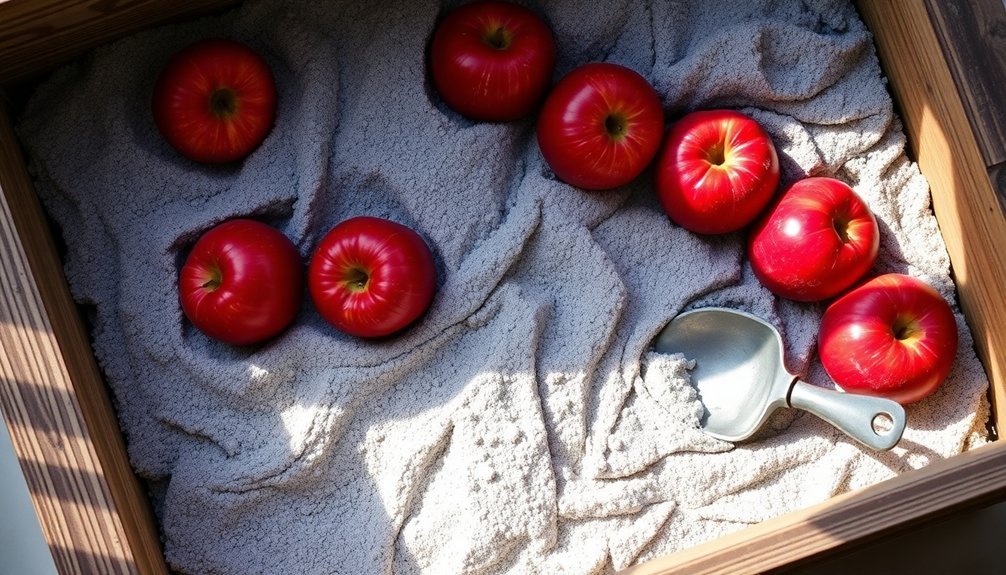
Storing tomatoes in wood ash requires careful attention to detail from the very beginning. You'll need to select firm, ripe tomatoes that are free from bruises and blemishes, ideally picking them at an early ripening stage. Long-keeper varieties work particularly well for this storage method. Based on research by ECHO Florida, this preservation technique has shown variable success rates with different tomato varieties.
Start by preparing your container – whether it's wooden, cardboard, or a woven basket. Line it with paper and create a 1.5-inch base layer of finely sifted wood ash from your cooking fire or chimney. You'll want to sift the ash multiple times to remove any sharp particles or debris.
Place your tomatoes stem-end down in a single layer, then cover them with a thin layer of ash. Continue this layering process until you've filled the container. Make sure you're covering the final layer of tomatoes with ash before sealing the container with a loose-fitting lid and packing tape.
Store your sealed container in a cool, dry, and dark place like a basement. While you can check on your tomatoes periodically, it's best to minimize disturbances. When done correctly, this method can keep your tomatoes fresh for up to 5-6 months.
Required Tools and Materials
Successful wood ash storage requires a specific set of tools and materials to keep your fruits fresh for months.
You'll need appropriate containers like wooden boxes, woven baskets, or earthenware crockery. These containers should be lined with paper to prevent direct contact between the ash and the container walls.
The most critical material you'll need is properly prepared wood ash. Make sure it's:
- Cool and thoroughly sifted to remove debris and sharp particles
- Collected from various tree species, such as chimney ash or cooking fire remains
- Dry and free of large residues that could damage the fruits
You'll also need several tools for handling and maintenance. Keep a knife handy for fruit inspection, along with a large spoon or trowel for moving the ash.
Don't forget to prepare a loose-fitting cover and a weight (like a stone or brick) to keep it in place.
For ideal storage conditions, you'll want to set up your storage area in a cool, dry, and dark location where you can control temperature and humidity levels to slow down the ripening process.
Common Storage Mistakes
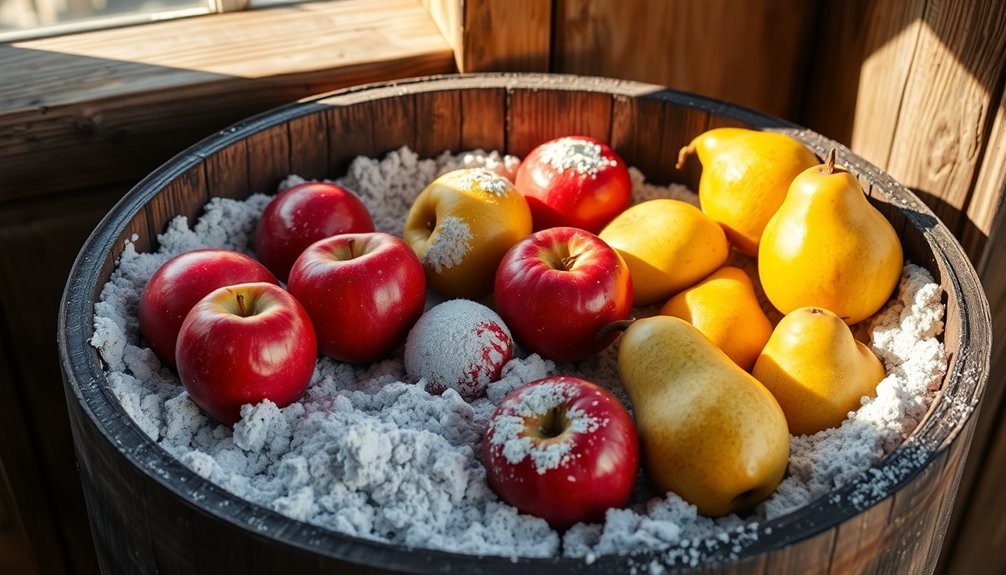
In wood ash storage, many gardeners make critical mistakes that can quickly spoil their fruits. One of the most common errors is using wet or contaminated ash that hasn't been properly sifted.
You'll need to sift your ash multiple times to remove debris and guarantee a fine consistency, as coarse particles can damage the tomatoes' skin.
Another critical mistake is selecting overripe tomatoes. You shouldn't use fully ripened or bruised fruits, as they'll deteriorate faster. Instead, pick tomatoes when they're just starting to change color from green to red.
Using tomatoes from charcoal ash is also problematic since it doesn't provide the same preservation benefits as wood ash.
Poor layering technique can lead to preservation failure. If you don't position the tomatoes stem-end down or fail to maintain consistent ash coverage between layers, you're risking premature spoilage.
Improper sealing and storage location choices will also compromise your preservation efforts. Don't forget to check your stored tomatoes every two weeks for signs of decay or mold.
If you notice strong odors or visual deterioration, you'll need to remove affected fruits immediately to prevent spreading contamination to healthy ones.
Temperature and Humidity Control
Two critical factors determine the success of wood ash storage: temperature and humidity levels. While wood ash itself doesn't control these conditions, you'll need to manage them independently for ideal fruit preservation.
Keep your storage area between 32-55°F, as lower temperatures slow down ripening and deterioration processes.
To maintain proper humidity levels (80-95%), you'll want to take into account these essential practices:
- Operate a humidifier in your storage space to maintain consistent moisture levels
- Use moisture barriers in your storage room's insulation
- Sprinkle water on the floor or lightly mist vegetables when needed
Remember that you can't rely on wood ash alone to create perfect storage conditions. Instead, you'll need to monitor and adjust both temperature and humidity regularly.
Keep your refrigeration system's coil temperature within 2°F of the room's air temperature for best results. While wood ash provides excellent antimicrobial properties and creates a protective barrier, it won't compensate for poor environmental conditions.
For maximum shelf life, combine proper wood ash storage techniques with consistent temperature and humidity control methods.
Nutritional Value Retention
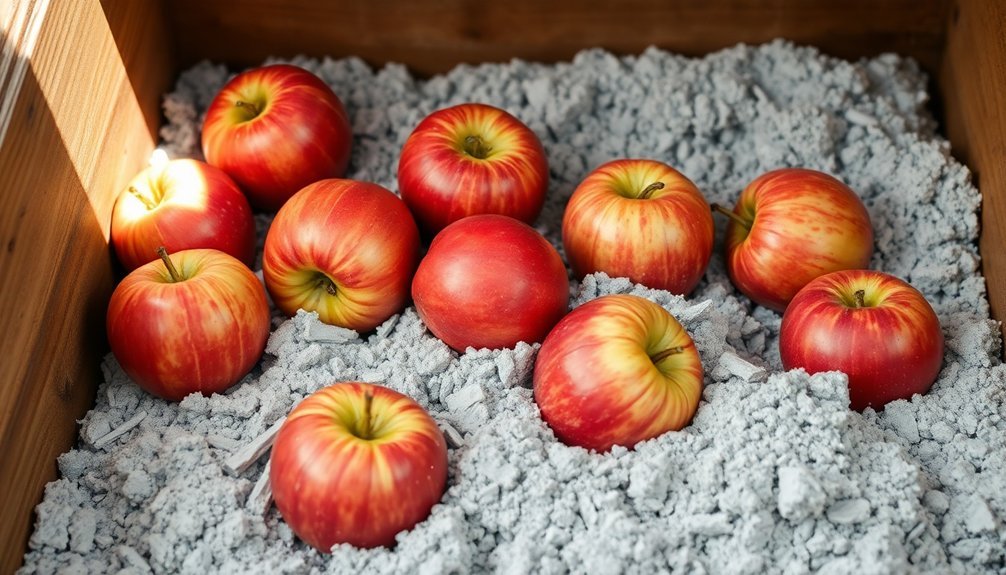
You'll find that storing fruits in wood ash effectively preserves vitamin C levels, with research showing particularly strong results in tomatoes where ascorbic acid content remains higher compared to conventional storage methods.
The antioxidant properties of your fruits get a boost during wood ash storage, as both phenolic compounds and lycopene content increase over time.
Your fruits' natural sugars are enhanced during wood ash storage, maintaining higher total sugar content compared to traditional sand storage techniques.
Vitamin C Stays Strong
Scientific studies reveal that wood ash's protective properties help maintain vitamin C levels in stored fruits, making it an effective natural preservative for nutritional value.
When you're storing fruits like tomatoes with wood ash, you'll find that the stable chemical environment created by the ash's alkaline properties helps protect essential nutrients from degradation.
The wood ash treatment's ability to reduce decay and maintain firmness directly contributes to preserving vitamin C content.
You'll notice these key benefits when using wood ash storage:
- The alkaline environment created by wood ash helps stabilize vitamin C molecules, preventing rapid oxidation
- The reduced decay rate (only 20% with 1.5 kg ash per 1 kg of fruit) means less nutrient loss during storage
- The preservation of fruit firmness helps maintain cellular structure, which protects vitamin C from breaking down
Even though you might experience some weight loss during storage, it won't greatly impact the vitamin C content.
If you're a smallholder farmer or live in an area without advanced storage facilities, you'll find wood ash particularly valuable for maintaining nutritional quality.
The method's simplicity and effectiveness make it an ideal choice for preserving both the freshness and nutritional value of your fruits.
Antioxidant Content Increases
Antioxidant powerhouses in fruits gain significant protection through wood ash storage methods. You'll find that wood ash treatment preserves higher levels of crucial phenolic compounds, including anthocyanins, flavonols, and flavones in your fruits. When you store grapes with wood ash, they'll maintain elevated levels of resveratrol, pterostilbene, and viniferin – compounds known for their exceptional antioxidant properties.
| Compound Type | Wood Ash Benefits | Storage Impact |
|---|---|---|
| Phenolic Acids | Preserves ferulic acid, quercetin | Extended shelf life |
| Antioxidants | Maintains catechins, vanillic acid | Reduced decay |
| Specific Acids | Higher trans-caffeic, p-coumaric levels | Better preservation |
You'll notice particularly strong results in grapes, where wood ash treatment leads to increased levels of trans-caffeic and trans-p-coumaric acids. The treatment's effectiveness extends to tomatoes too, where it helps maintain nutritional parameters while slowing down firmness reduction. This preservation method doesn't just work on specific fruits – it's adaptable across various produce types, making it an excellent choice for small-scale farmers looking to maintain their fruits' antioxidant content and extend shelf life naturally.
Natural Sugar Enhancement
Studies reveal mixed effects of wood ash storage on fruits' natural sugar content and nutritional value retention. When you store tomatoes in wood ash, you'll notice they tend to develop higher sugar content over time compared to sand storage. This increase happens as starches break down into simpler sugars, though the difference isn't statistically significant.
The relationship between wood ash storage and sugar development shows some interesting patterns:
- Your fruits will maintain their total soluble solids, which is a key indicator of nutritional content, regardless of the ash treatment used.
- You'll find that using 1.5 kg of ash per 1 kg of tomatoes gives you the best results for extending shelf life.
- Your tomatoes will experience slightly higher metabolic activity in ash, which affects both sugar content and pH levels.
While the ash storage method won't dramatically alter your fruits' sugar profile, it does provide a practical preservation option, especially if you're in an area without reliable refrigeration.
The process involves natural sugar enhancement through controlled ripening, though you'll need to monitor the firmness of your produce, as it tends to decrease over time regardless of the storage method.
Shelf Life Extension Methods
Throughout the years, researchers have developed numerous methods to extend the shelf life of fresh fruits, ranging from traditional techniques like drying and canning to cutting-edge approaches involving nanotechnology and smart packaging. You'll find that modern preservation methods now combine multiple strategies to maximize effectiveness, including modified atmosphere packaging and smart stickers that can add up to two weeks of freshness.
| Method | How It Works | Shelf Life Impact |
|---|---|---|
| Modified Atmosphere | Controls gas composition | 2-3x longer shelf life |
| Smart Stickers | Reduces ethylene effects | Up to 14 days extra |
| Freeze Drying | Removes water via sublimation | Several months |
| Nanotechnology | Uses nano-particles for preservation | Various improvements |
| Wood Ash Storage | Natural preservation method | 2-3 weeks for tomatoes |
You can choose from various preservation techniques depending on your needs. Traditional methods like drying and canning remain reliable options, while newer technologies offer exciting possibilities. If you're looking for natural solutions, wood ash storage has shown promise for certain fruits like tomatoes, though it's not as effective as modern methods. For the best results, you might want to combine multiple preservation strategies, such as using both modified atmosphere packaging and temperature control.
Storage Container Selection
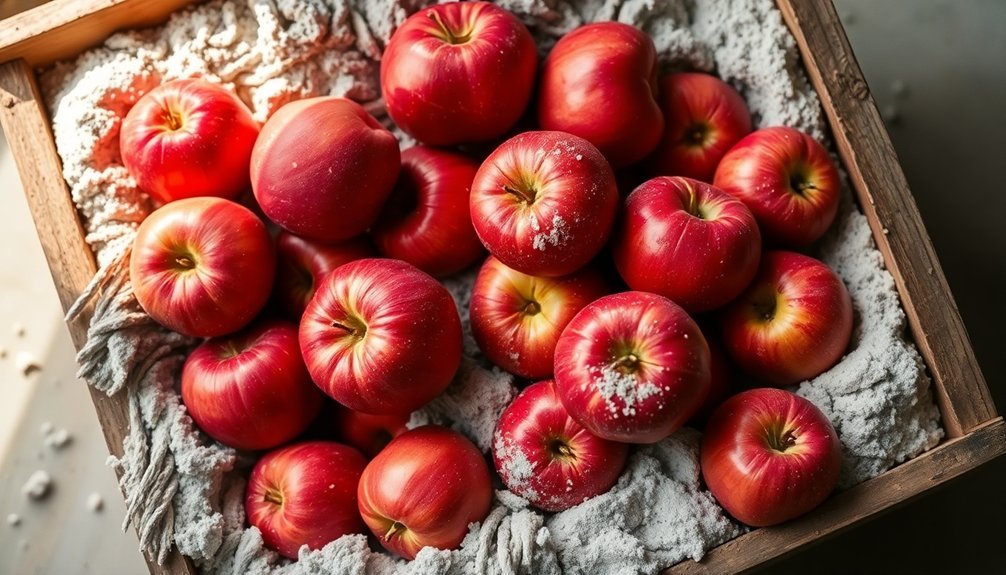
You'll need containers made from moisture-resistant, alkaline-compatible materials like plastic, glass, or properly-treated wood to effectively store fruits in wood ash.
Your container's size should accommodate multiple layers of fruit and ash while maintaining a depth of at least 2-3 inches of ash between layers and around the edges.
The container should have minimal air circulation features, with just enough ventilation to prevent moisture buildup without compromising the protective ash barrier.
Material Types For Containers
Selecting the right container materials is essential when storing both wood ash and fresh fruits. When handling wood ash, you'll need heavy-gauge steel containers with tight-fitting, airtight lids to prevent embers from escaping. These non-combustible containers guarantee safety and durability while resisting corrosion and high temperatures.
For storing fresh fruits, glass containers are your best option. They're non-porous, easy to clean, and won't leach harmful chemicals into your produce. Unlike plastic alternatives, glass provides superior moisture control and temperature regulation, helping extend the shelf life of your fruits.
Key considerations for both storage types include:
- Heat resistance and durability for ash containers to prevent fire hazards
- Airtight seals to maintain freshness in fruit storage and contain embers in ash containers
- Easy-to-clean surfaces to maintain hygiene and container integrity
Remember to place your ash containers on non-combustible surfaces and verify they're far from flammable materials. For fruit storage, opt for glass containers with secure lids to maintain ideal humidity levels and prevent contamination.
These material choices will help you safely store both wood ash and keep your fruits fresh for extended periods.
Size And Depth Requirements
When choosing containers for wood ash fruit storage, proper size and depth specifications are essential for success.
You'll need a container that's large enough to accommodate multiple layers of both tomatoes and ash while maintaining adequate spacing. The container must be deep enough to start with a 1.5-inch (4 cm) base layer of ash and allow for several alternating layers of tomatoes and ash on top.
Select a container based on your storage needs, as the size directly affects how many tomatoes you can preserve.
When layering, place your tomatoes stem-side down in a single layer, guaranteeing they don't overlap. After each layer of tomatoes, you'll need space to add a thin coating of ash before starting the next layer. Your container should have enough depth to repeat this process several times while leaving room for a final ash layer on top.
Remember that your container needs to accommodate a secure cover that will keep the ash undisturbed.
Whether you're using a wooden box, cardboard container, or woven basket, confirm it's sturdy enough to support the combined weight of the ash and tomatoes throughout the storage period.
Air Circulation Features
Proper air circulation stands as a critical factor when choosing storage containers for wood ash fruit preservation. You'll want to select containers that promote adequate airflow while maintaining the protective properties of the wood ash. The right balance of ventilation helps prevent moisture buildup that could lead to fruit spoilage or mold growth.
When setting up your storage system, consider these essential air circulation features:
- Use containers with small perforations or natural pores, like earthenware or woven baskets, which allow air movement while keeping the ash in place.
- Position your containers slightly elevated from the ground and away from walls to enable air to flow freely around all sides.
- Leave adequate space between stacked containers if you're storing multiple units.
You'll need to place your storage containers in areas with natural air movement, but avoid spots with strong drafts that could disturb the ash.
If you're using an enclosed space, you might want to install small fans for controlled air circulation. Remember to regularly monitor the airflow and adjust container positions if you notice any condensation or unusual odors developing.
Traditional Preservation Wisdom
Throughout history, civilizations have developed ingenious methods to preserve fresh fruits beyond their natural shelf life. When you're looking to preserve fruits traditionally, you'll find several time-tested techniques that have proven effective across generations.
You can start with sun drying, one of the oldest preservation methods, by placing fruits on trays in direct sunlight to remove moisture and prevent spoilage. If you live in areas with limited sunlight, you'll find home dehydrators or still houses equally effective. For a more controlled environment, you can use your conventional oven to achieve similar results.
Traditional canning methods offer another reliable approach. You'll need to cook fruits with sugar or syrup before sealing them in sterilized jars, creating an environment where harmful bacteria can't survive.
If you're interested in more flavorful preservation, try making jams and jellies by combining fruits with sugar and pectin, or experiment with pickling using vinegar and spices.
For long-term storage, fermentation provides both preservation and probiotic benefits. You can also try sugaring, which draws out moisture from fruits using honey or sugar, effectively preventing bacterial growth.
Best Wood Types
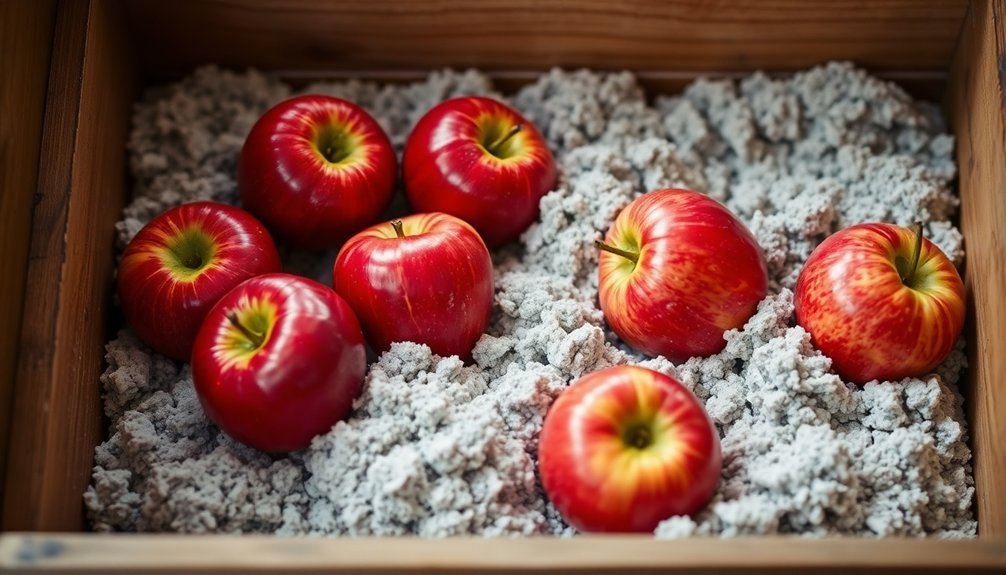
Building on these traditional preservation methods, selecting the right wood for ash production plays a key role in fruit preservation success.
While research shows that different wood types contain varying mineral compositions, the ECHO Florida study didn't find significant differences in preservation effectiveness between various wood sources when storing tomatoes.
You'll want to take into account these key aspects when selecting wood for ash production:
- Choose locally available hardwoods, as they're often used successfully in regions like Nigeria and Uganda where wood ash preservation has shown positive results.
- Avoid treated or contaminated wood sources that might introduce harmful chemicals into your storage system.
- Use thoroughly burned, clean ash that's been properly sifted to remove large particles.
When you're producing ash for storage, remember that the source material's quality matters more than the specific tree species.
While future research may reveal ideal wood types, current evidence suggests you can work with any clean, well-burned wood ash.
If you're experimenting with this method, you might want to document which wood sources you're using to track any variations in preservation effectiveness over time.
Frequently Asked Questions
Can Wood Ash From Barbecue Grills Be Used for Fruit Preservation?
You can use barbecue grill wood ash for fruit preservation, but you'll need to sift it carefully to remove contaminants. Make sure it's pure wood ash without any charcoal or chemical additives.
Does Wood Ash Storage Affect the Taste of Stored Fruits?
You won't notice significant taste differences in fruits stored in wood ash, though they may have slightly higher sugar content. While the skin might wrinkle, the inside stays juicy and maintains its original flavor.
How Often Should Wood Ash Be Replaced During Long-Term Storage?
You don't need to replace wood ash during storage, as it's a one-time layering process. Once you've properly layered your fruits with ash and sealed the container, leave it undisturbed until use.
Can Fruit With Minor Blemishes or Damage Be Preserved in Wood Ash?
You shouldn't use tomatoes with any blemishes or damage in wood ash storage. Even minor imperfections can lead to faster decay and compromise the preservation process. It's best to select only unblemished fruit.
Is It Safe to Consume Fruits Immediately After Removing From Wood Ash?
You shouldn't eat fruits immediately after removing them from wood ash. You'll need to thoroughly rinse them first to remove all ash particles from the surface. After proper cleaning, they're safe to consume.
In Summary
You'll find wood ash storage to be a reliable, time-tested method for preserving fresh fruits. Don't overlook this traditional technique that's both cost-effective and environmentally friendly. By following proper storage methods, selecting the right wood types, and avoiding common mistakes, you can extend your fruits' shelf life by several months. Remember to check your stored fruits regularly and maintain ideal moisture levels for best results.





Leave a Reply